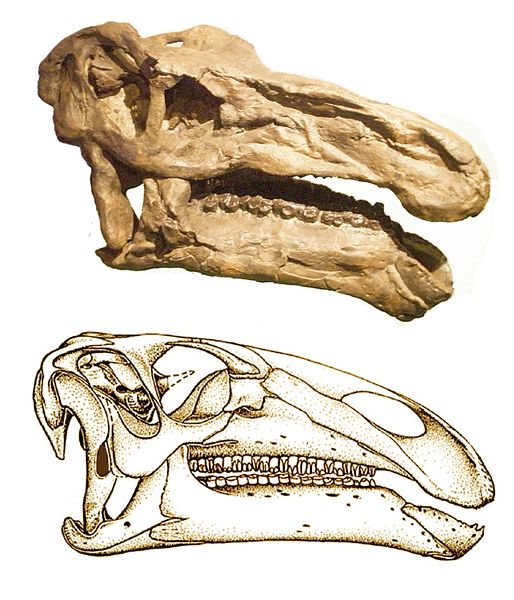Athena Review Image Archive ™
Iguanodon bernissartensis skull

Skull of Iguanodon bernissartensis (after 2)
Iguanodon
bernissartensis was
a large plant-eating dinosaur, widespread in Asia, North America, and
Europe during a two million-year interval at the end of the Jurassic
and start of the Cretaceous periods (126-124 mya).
The genus Iguanodon ("iguana tooth") is currently identified within the larger group Iguanodontia, along with the duck-billed hadrosaurs. The type species Iguanodon bernissotensis is named for a site in Belgium where many well-preserved specimens were found starting in the 1880s.
The earliest Iguanodon fossils were found in 1822 by Gideon Mantell, who discovered the first fossil Iguanodon teeth, and eventually found much of its skeleton. Mantell (1825) originally identified that the teeth of Iguanodon were similar to those of a herbivorous reptile such as the Iguana (hence the genus name he selected). It also had other features unlike any modern reptile, such as a toothless, scoop-shaped symphesis or tooth vacancy of the lower jaw, which Mantell saw as a functional analogy with modern herbivores such as the giraffe.
The Iguanodon
skull was long and narrow, with a projecting keratin beak. The
upper jaw held up to 29 chisel-like teeth per side, lacking any at the
front of the jaw; while the lower jaw had 25 teeth meeting the upper
teeth, but broader. Because the reptilian teeth were continually
replaced, Iguanodon could eat tough plant material such as tree leaves and grasses.
References:
Mantell, G.A., 1841. Memoir on a portion of the lower jaw of the Iguanodon and on the remains of the Hylaeosaurus and other saurians, discovered in the strata of Tilgate Forest, in Sussex. Philosophical Transactions of the Royal Society of London, 131: 131–151
:
Copyright © 1996-2020 Rust Family Foundation (All Rights Reserved).